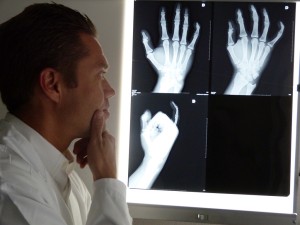 In hand surgery two souls coexist. The soul “orthopedic” is dedicated to reconstruct the bone-cartilage components torn by aging or any important trauma after an acute incident. The soul “Plastic and Reconstructive” is dedicated to reconstruct soft tissues or to correct congenital malformations. In the best expression of my specialization the two souls join each other.
In hand surgery two souls coexist. The soul “orthopedic” is dedicated to reconstruct the bone-cartilage components torn by aging or any important trauma after an acute incident. The soul “Plastic and Reconstructive” is dedicated to reconstruct soft tissues or to correct congenital malformations. In the best expression of my specialization the two souls join each other.
Moreover Hand Surgery is usually linked to reconstructive microsurgery in terms of restoring the sensitivity of the hands or to maintain the viability of a distal part after a post-traumatic transient ischemia. Reconstructive microsurgery is often more challenging and longer than most orthopedic procedures and requires a long training to learn all technical skills. At the Microsearch Foundation of Australia in Sydney, only people having a success rate of 90% doing the aforementioned procedures for training could go on humans. This is called medical ethics.
“Basic” Hand surgery is nowadays performed by many doctors, but the most complex and long operations are in the hands of who have spent a long surgical and mircrosurgical training in a certified and accredited Hospital for hand surgery teaching and a proven CV. Only the frequency of years in close contact, inside and outside the hospital, with Professors that become mentors is the way to reach the excellence.
My ethics move me to treat patients respectful of His/Her illness and discomfort, regardless of the social class, race, skin color or type of insurance.
Each time the patient comes into my office or operating room, the care is never delegated to anyone from the beginning to the end and before starting any visit I should answer positively to the following 6 questions:
1) I know the diagnose;
2) I have already done a long training to treat this condition;
3) I have the experience/skills to perform that operation;
4) I have the team and structure to perform that operation;
5) I have the time to take care of the patient;
6) I am able to manage any complications.
The usual daily grind I’m experiencing is a continuos referral of patients to the Locarno Hand Center by colleagues not board certified as specialists in hand surgery, that after treating for weeks or months with misdiagnoses or mistreatments finally download their patients asking for a fast improvement and minimal consequences in the long-term
Dr.Lucchina’s fields of interest are:
-peripheral neuropathies like entrapment syndromes or dysmetabolic ones treated by endoscopic techniques or mini-invasive (carpal tunnel syndrome and ulnar nerve compression at the elbow). The advantage of endoscopic or US-guided treatment of these syndromes is not only to minimize the risk of an unaesthetic scar but also to reduce dramatically the recovery time post-operatively with a faster return to work. The long-term results are excellent with several advantages for the patient compared to the traditional surgical techniques. Occasionally a postoperative transient palmar pain at the scar (“pillar pain”) can appear in grasping objects but in general there are rare complications with a minimal pain after surgery.
– osteoarthritis of the fingers, base of the thumb and wrist as well as ligament injuries of the wrist and thumb with arthroscopic technique
The classical surgical treatment for basal thumb joint arthritis is represented by the removal of the trapezium bone and joint reconstruction using the flexor carpi radialis tendon or abductor pollicis longus interposed within the neo-articulation. The alternative arthroplasties represented by the use of spacers for intermediate stages of the disease, however, is at risk of dislocation or wear of the prosthetic materials used. An arthroscopic procedure allows to perform a synovectomy and loose bodies removal with a secondary reduction of pain. Thanks to arthroscopy the surgeon can also detect an initial degeneration of the cartilage on the opposing articular surfaces. If the cartilage is still intact, then the patient can benefit from a reinforcement of the capsule (capsulodesis) to reduce the laxity. This step may alter the arthritic process and give a reduction of symptoms without the side effects of intraarticular steroids. The X-ray evaluation often show only slight cartilagineous alterations but arthroscopy can show the true level of osteoarthritis based on a direct visualization of the loss of cartilage. This allows the clinician to perform an osteotomy earlier in the disease and an arthroscopic suspension arthroplasty in more advanced stages. If there is loss of cartilage, patients may benefit from arthroscopic debridement, and a shrinkage to stabilize the joint. The hand surgeon can perform a corrective osteotomy with limited incision to alter the biomechanics of the joint. The metacarpal can be centralized on the trapezium, preventing subluxation and chronic instability leading to final osteoarthritis.
If the damage of the articular cartilage is really advanced, the surgeon can remove the cartilage from the trapezium by increasing the joint space. This minimizes contact between the trapezium and the first metacarpal bone. Moreover, this procedure causes bleeding from the subchondral bone, producing blood clots that adhere to the tendon graft. The tendon graft is inserted into the joint by adhering to blood clots and acting as a pillow/spacer between the opposing articular surfaces. This generates a good pain relief with mild postoperative pain
-the microsurgical reconstruction of nerve lesions and peripheral palsy of the upper and lower extremity, with particular attention to road and work traumas
-the development of techniques for restoration of the function lost after accidents, reducing the time out of work or sports
-reconstruction of the upper limb after nerve paralysis on the basis of congenital or cerebrovascular disease to improve the cosmetics, hygiene or function
-the microsurgical reconstruction of tissue losses of the upper limb as a result of accidents, cancer or skin diseases by reducing the aesthetic and functional sequelae.


